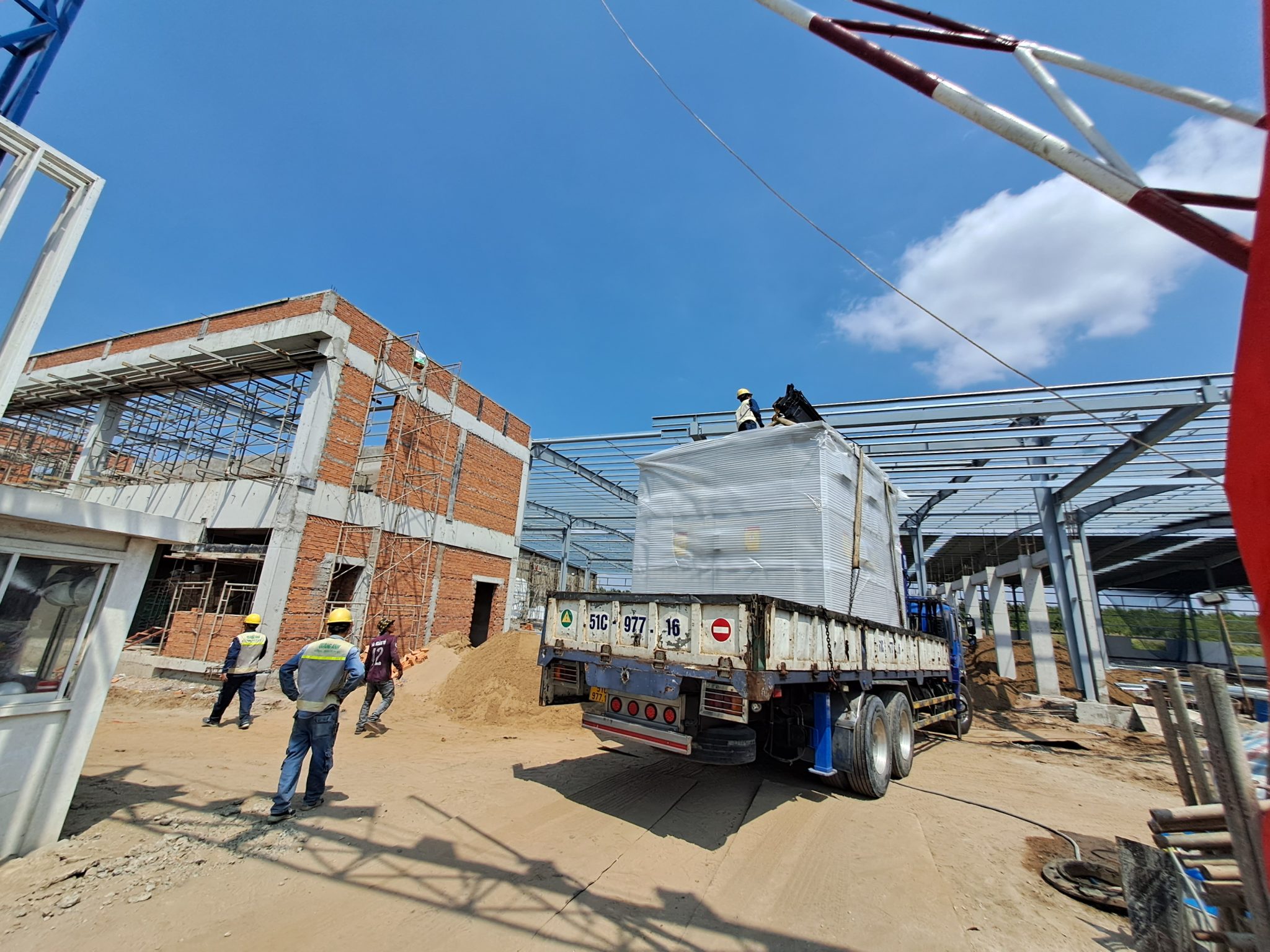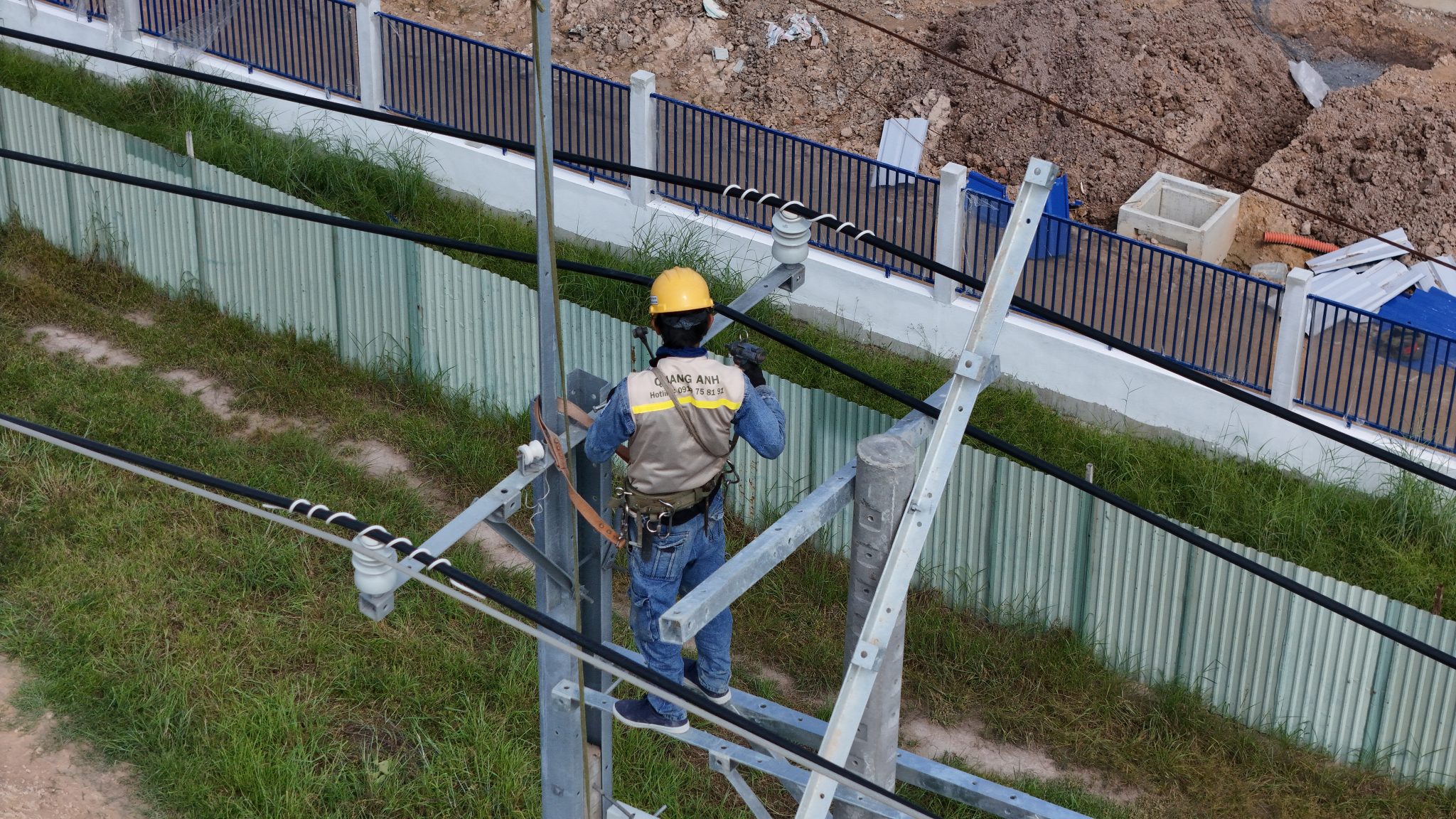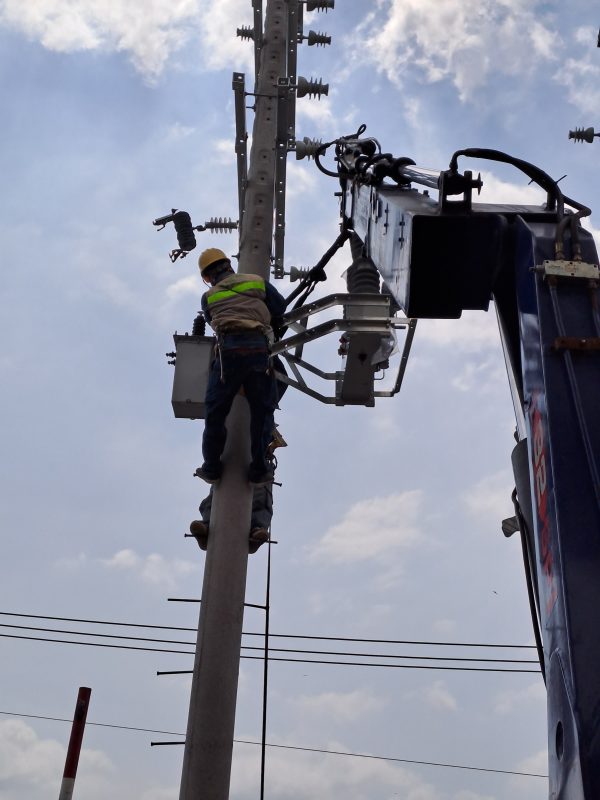Installing an industrial electrical system requires meticulous procedures and adherence to high technical standards to ensure safety and efficiency.
Installation Process for Industrial Electrical Systems
The installation demands careful preparation and a clear process, starting with equipment like transformers, factory electrical cabinets, and protective devices such as CBs and relays. On-site surveys are then conducted to measure and analyze the customer’s power needs. Lastly, detailed designs adhering to standards like IEC 60364 or TCVN ensure safety and cost optimization. Each step requires close supervision for accuracy and safety.
Installing industrial electrical systems is a complex procedure blending technical expertise and safety. For effective, long-term operation, the following key steps should be observed:
- Preparing Equipment
- Ensure all necessary installation equipment like Thibidi transformers, Mitsubishi electrical cabinets, or Schneider protective devices are ready to facilitate the process smoothly.
- Personnel must be equipped with full protective gear for safety assurance.
- Site Survey
- Gather and process information on power usage needs and site conditions.
- Conduct an actual site survey to draft an effective, suitable construction plan.
- Electrical System Design
- Based on survey data, detailed electrical drawings compliant with IEC 60364 standard are created to ensure a safe and cost-effective system.
- Analyze and adjust drawings for optimal system operation.
- Installation Execution
- Implement installation as per approved design, prioritizing compliance with electrical safety standards.
- Ensure safety for both workers and equipment throughout the installation process.
- Testing and Inspection
- Following installation, the system undergoes thorough testing and trial runs to ensure stable operation.
- Complete handover procedures and gather customer feedback to improve service quality.
Optimizing installation and operational costs, while strictly adhering to technical standards, are crucial factors for the long-term success of any industrial electrical system.

Specialized Equipment and Materials in Electrical Installation
Utilizing specialized equipment and materials is vital in industrial electrical installations. Key components include distribution boards (MSB), motor control centers (MCC), and backup generators, as well as protective devices like ELCB and surge protectors for safety. The selection of cables, such as XLPE underground and high-temperature insulated cables, is crucial in industrial environments.
Specialized equipment and materials play essential roles in both industrial and domestic electricity setups, with suitable choices ensuring safety and performance.
Domestic Electrical Devices include:
- Breakers, Circuit Breakers, Fuses: These devices protect circuits by automatically disconnecting in overload or short circuit conditions.
- Electric Meters: Essential for measuring power consumption, aiding energy management.
- Outlets, Switches: Control the distribution of power to individual devices.
- Wires: Classified by cross-section and materials like copper or aluminum, crucial in electrical design.
Industrial Electrical Equipment shows distinct differences, especially in high and medium voltage applications:
-
High Voltage Devices used on high voltage networks from 74kV to 800kV:
-
High Voltage Circuit Breakers: Interrupt high voltage circuits utilizing SF6 or vacuum technology.
-
Current Transformers (CT) and Isolating Switches: Protect the system by measuring current and creating safe maintenance spaces.
-
Medium Voltage Equipment offers optimal choices like:
-
Reclosers and Contactors: Automatically restore circuits post short circuit incidents.
-
Surge Protective Devices (SPD): Shield against electrical surges caused by storms or switching operations.
-
Voltage/Potential Transformers (VT/PT): Lower voltage for safe measurement and monitoring.
Mechanical and Electrical (M&E) Materials are equally significant:
- Ventilation and Insulation Ducts: Made from heat-resistant materials like fiberglass, enhance HVAC system efficiency.
- Stainless Steel Straps and Cabinet Sheets: Used for securing and protecting in harsh environments, with enclosures often from galvanized steel or flame-retardant composite.
Specialized Electrical Cabinets:
- Distribution Boards (DB): Distribute power to smaller circuits, integrating devices like MCCB/RCCB.
- Motor Control Centers (MCC): Manage three-phase motors and protect motor operations effectively.
- Reactive Power Compensation Cabinets: Reduce power loss, boost efficiency using shunt capacitors.
Additionally, Installation Support Materials:
- Copper/Aluminum Busbars are main conductors in many distribution board applications.
- Silicone Insulation Sealants play crucial roles in ensuring junction safety.
- PVC/PPR Conduit Pipes: Protect wires from environmental factors.
Standards and Technologies are also clearly applied:
- Insulating Materials must withstand atmospheric voltages per IEC 62271 standards.
- IoT Measurement Technology with temperature/humidity sensors supports efficient remote monitoring.

Challenges and Modern Trends in Industrial Electrical Systems
Industrial electrical installations face challenges such as system complexity and safety risks due to miscalculations or harsh weather. Investment costs are significant, requiring high-quality materials and skilled labor. However, modern trends like using VFDs for motors and dimmable industrial LED lights effectively save energy. Additionally, IoT sensor integration for automatic load balancing is a notable industry trend.
Amid rapid development, Vietnam’s industrial electrical systems face major challenges. A primary issue is the imbalance between power supply and demand, particularly in the North, where no new energy sources lead to reliance on transmission from other regions, stressing the grid.
The fast-growing power consumption due to industrial and residential expansion increases pressure on the existing electrical systems, requiring continuous upgrades to meet demands. Conversely, traditional energy sources like water and fossil fuels are depleting, necessitating a shift to renewable energy for long-term stability.
Addressing this, electricity pricing policies and reinvestment into the system are essential aspects warranting attention. To sustainably maintain and develop the grid, a reasonable electricity pricing mechanism helps secure strong financial resources.
Modern trends emphasize renewable energy adoption. Sources like solar and wind reduce reliance on fossil fuels, minimizing environmental impact. Concurrently, the development of smart grids is a major advancement, enhancing system efficiency and flexibility through advanced edge computing and IoT technologies.
Digital integration and data analytics assist in efficient management and supervision of electrical systems, allowing precise demand forecasting and optimal distribution. Investing in new infrastructure such as smart substations and microgrids is an inevitable trend in tackling current challenges, ensuring sustainable industrial electrical system advancement.
Technologies like VFDs optimize energy consumption and improve motor management. Automatic load control significantly contributes to balancing demand and supply, reducing grid pressure, and enhancing system stability.

Installing industrial electrical systems not only demands precise procedures and adherence to technical standards but also offers significant technical, investment, and strategic benefits. Modern trends like IoT sensor integration and energy optimization enhance operational efficiency, reduce costs, and increase safety.
For optimal industrial electrical system implementation, contact QuangAnhcons at +84 9 1975 8191.
QuangAnhcons provides comprehensive industrial electrical system installation services with international standards, ensuring high safety and efficiency, including complete surveys, design, installation, and maintenance.


Related Posts
Factory Electrical Systems: Comprehensive Design and Implementation Guide
Discover the detailed and safe process of factory electrical systems design and implementation. [...]
Oct
Blueprints Required for Factory Construction Permits
Discover the necessary blueprints in factory construction permit applications, from floor plans to electrical and [...]
Oct
What Are the Requirements for a Factory Construction Permit? A Comprehensive Guide
Explore the documentation and steps needed to secure a factory construction permit for streamlined project [...]
Oct
Factory Construction Permit Procedures in Vietnam: Essential Guidelines and Documents
Learn the procedures for securing a factory construction permit in Vietnam, focusing on document preparation [...]
Oct
Key Steps in the Factory Construction Process
Discover the essential steps and requirements for building factories. [...]
Oct
Comprehensive Electrical Substation Solutions by Quanganhcons
Discover the cutting-edge electrical substation solutions offered by Quanganhcons for industrial applications. [...]
Oct
Investment Costs for a 1MWp Solar Power System and Influencing Factors
Explore the investment costs for a 1MWp solar power system in Vietnam and the influencing [...]
Sep
QuangAnhcons: Elevating Wind Energy Solutions
Explore QuangAnhcons' leadership in wind energy and renewable solutions in Vietnam. [...]
Sep
Electrical Contractor Strategies at Becamex Industrial Park
Discover the strategic advancements and partnerships of the electrical contractor at Becamex Industrial Park. [...]
Sep
Investment Insights for 1MW Wind Energy in Vietnam: Costs and Opportunities
Discover the detailed analysis of costs and opportunities for investing in 1MW wind energy projects [...]
Sep
Advanced Electrical Installation Solutions by QuangAnhcons
Explore advanced electrical installation solutions and modern technology with QuangAnhcons. [...]
Sep
Enhancing Industrial Electrical Services with Quanganhcons
Discover Quanganhcons' expertise in industrial electrical services, offering efficient and sustainable power systems. [...]
Sep
Comprehensive MEP Solutions by QuangAnhcons: From Design to Maintenance Excellence
Discover optimal MEP solutions with QuangAnhcons, dedicated to excellence from design through maintenance. [...]
Sep
Comprehensive Electromechanical Contracting Solutions by QuangAnhcons
Explore QuangAnhcons' comprehensive services for efficient and safe energy system solutions. [...]
Sep
QuangAnhcons: Empowering Industrial Energy Solutions
Discover how QuangAnhcons delivers optimal industrial EPC solutions. [...]
Sep
Effective Industrial Construction Management and Execution
Optimize your industrial projects from design to execution with our contractor services. [...]
Sep
QuangAnhcons: Pioneers in M&E and Renewable Energy Solutions
Discover QuangAnhcons' innovative M&E services and renewable energy solutions. [...]
Sep
QuangAnhcons: Expertise and Outstanding Services in the Electrical Sector
Discover the unmatched expertise and services of QuangAnhcons, setting superior standards in the electrical contracting [...]
Sep
QuangAnhcons: Innovation and Precision in Industrial Electrical Contracting
Discover QuangAnhcons, a top contractor offering superior electro-mechanical solutions. [...]
Aug
Expert Solutions for 2x2500kVA Substation Projects with QuangAnhCons
Explore QuangAnhCons, a forefront entity in designing and constructing large industrial substations. [...]
Aug